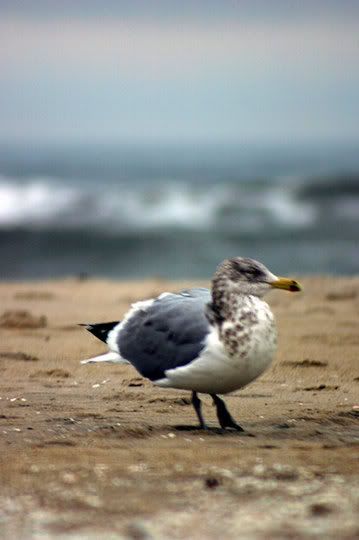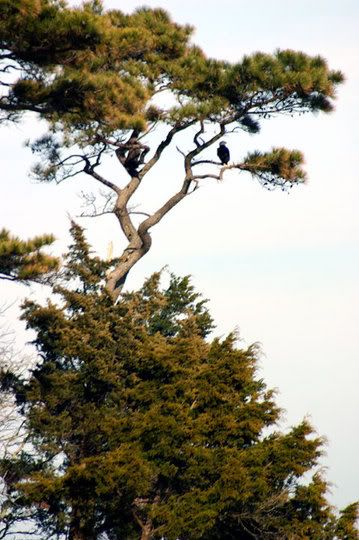While the lion's share of the reclaimed hours will be given to the studio, I also plan to spend more time with the artists, curators and gallery people I enjoy, strengthening loose friendships and generally "putting myself out there" a little more. Approaching thirty and planning to leave NYC within the next three to five years, I want to secure the Art World umbilical while I'm living here; despite my misgivings about the Art World - regular readers know just how often I hem and haw - I do want to maintain my relationship with the inner circle, coming into the city several times a year to crash on couches, see tons o' art and generally make a nuisance of myself.
Anyway, I'm feeling awfully vacant. I just looked at the clock and suddenly thought, Shit! It's 11:56 PM!? How'd that happen?, yet it's sunny outside and I'm at the day job. Given this inability to process much of anything in a reasonable manner, I won't continue working on any of the posts in progress. Instead, I'm posting a few more pictures, with commentary, taken over the holidays.
+++++

Even the most experienced birders sometimes struggle with gull identification. Most people are content to lump any and all species into one category: "seagull," a misnomer and generalization that drives me batty. The "seagull" above is, I believe, a third winter Herring gull (Larus argentatus), though it could be a younger bird, perhaps only in its second winter.
I'm a great admirer of gulls. They are adaptable survivors, sure to be among those trophic generalists which will live on after humanity plunges into a period of dark recession. Spend enough time around the various gull species and their characteristic behaviors become as distinct as their plumage. The chatty, almost gleeful laughing gull (Larus atricilla), for example, loves to dip and dive behind the farmer's plow, while the great black-backed gull (Larus marinus), bulky, predatory and cruel (by our standards), will stare you down for long minutes, waiting for some bit of fish flesh to be carelessly dropped on a seaside fish cleaning dock.
Most people love the raptors, particularly the Accipiter and Falcon families, and I am no exception. These hunters preoccupy the human imagination for the same reason the tiger and jaguar do, speaking not only to the biological imperative, but to our celebration of the individual, despite our sharing more in common with the pack hunters - the wolf, for example - and the scavengers. All the same, I have come to prefer the company of the noisy Laridae clan. They seem the more honest creature. If my life should take me inland, away from the Atlantic or Pacific coasts, I hope to land in an area where gulls make a living. Crows and gulls, in a word, rock.

My buddy, Fred, a biologist and teacher living in Washington, D.C., prepares to shoot a photograph of a sanderling (Calidris alba) on the beach at Assateague, in Virginia. At some point in the near future I'm supposed to see all the photographs he took during his visit, just after Christmas 2005. If I scan them or, better yet, get digital copies, I will post the better images here with some commentary.

A decade ago, bald eagles (Haliaeetus leucocephalus) were a rare site on the Eastern Shore. Today, however, there are nesting pairs established in many areas of the peninsula and I was lucky enough to see this particular pair in a tall pine near the marsh. One of the two birds is easy to spot, on the right, but the second eagle is in shadow and partially obscured by a branch close to the center of the frame. Determined to get a really nice shot of the pair, I attempted to sneak closer, but the "eagle eyes" did their thing and the two big raptors dropped from their perch and crossed the marsh to the northwest.

This last photo was taken in a thrift store. The ceramic plate was hanging on a wall, among many other, similar plates. Most featured more standard phrases, familiar to those readers who have spent some time in "cute," southern kitchens: "Home Is Where The Heart Is," "Healing Starts With The Heart...And A Hearty Meal," and other equally annoying drivel. Then there was this one. It's not funny, really, but it sure is strange.
Photo credit: all photos 2005, Hungry Hyaena

7 comments:
I like that gulls can drink seawater because they have modified tear dcts to extract the salt. If you watch them, they will shake their heads and a couple of drops of liquid will fly out (called bird snot by the learned). Word on the street is that if a bunch of movie popcorn, say in a Regal Cinemas parking lot in Trenton, the liquid will actually be yellow. On one hand I'm inclined to believe it (think pee and coffee or asparagus). On the other hand I think "Get the F^<# out, who knows that kind of stuff."
If any of you intrepid souls care to verify that...
My mother once managed some beehives near a zoo. The combs were dotted with cells filled with pink honey--made from cotton candy.
My field guide lists but two gull species. You got your black-headed gull and your white-headed gull.
I saw an interesting thing as I was driving home from work today. A red-tailed hawk had killed a gull and was 'stomping on it' by the side of the road. I, of course, veered over and waved the other, annoyed drivers around me (but I felt myself to be well justified considering that another driver had, moments before, almost run into me head-on by being in the wrong lane).
When the hawk flew to a nearby branch to eat, it looked as if two birds where flying in tandem... I was quite suprised, because the two girds are roughly similar in size. I wonder if it was full on predation or an act of opportunism...
Either way it was a nice end to a decent lunch shift.
Michael:
The first comment was interesting. I think I'd read about gull desalination ability in the past - I wonder if it's specific? - but I'd forgotten. Thanks for reminding me of one more exceptional aspect of the birds.
The second comment excites me...which might point to my dorkdom, but whatever. That's a great sight! I have to assume the hawk was scavenging, but you never really know unless you see the blow struck, so to speak.
CPBVK:
Well, I suppose two kinds is better than one. ;)
As much as I value precision in taxonomical terminology, if even experienced birders have trouble identifying gulls, what's the damage in using the neutral term seagulls? They are definitely gulls, and they are from the sea - they come upriver on barges. But I have no idea what type they are.
I'd rather refrain from attempting an species identification than get it wrong - they are definitely from the Pacific, but I have no idea if they are "Pacific gulls," so I wouldn't call them that. Would you prefer they simply be called "gulls" and not the common term "seagulls"?
Just curious. There are very few animals which I can with confidence identify beyond genus level! I'm a molecular type of biologist, after all. :)
Bioephemera:
You asked: "Would you prefer they simply be called 'gulls' and not the common term 'seagulls'?"
Yes...and I should have specified that in the post.
I've no problem with using neutral, general terms to describe unidentified species. My passerine identification abilities are limited (actually, they're downright dismal). As a result, I call most species of sparrow...well, sparrows. The only two I can name with any consistency/confidence are the song sparrow (Melospiza melodia) and the house sparrow (Passer domesticus).
My problem with the term seagull is the prefix modifier. When people call an unidentified gull species a gull, that's appropriate. I do it all the time, especially during winter when the plumage can make identification difficult. But when they're standing by a field in Oklahoma, watching hundreds of gulls dive behind a tractor, and they say, "Look at all the seagulls," they're likely assigning a relationship between gull and ocean that doesn't exist.
Although all gull species are "shorebirds," many are found near the shores of inland waterways. I suppose many rivers, lakes and, in some cases, ponds can be tied to the ocean at one end or another. Even so, most "inland" gull species have little interest in divining sources or destinations. Call them river gulls, or lake gulls...or just gulls.
Admittedly, my aversion to the term seagulls goes further. It irks me when species that are found at the ocean's edge are referred to by that catch-all. I still prefer "gull." Rationally speaking, that preference may be a bit much, I suppose...but we all have our little picadillos. ;)
Good points. I guess I am just used to the word "seagull;" I have never actually met a person (besides the ecologists) who calls them "gulls." Perhaps it's a regional usage preference. . . to me, the word "gulls" suggests "gullible people" just as readily as it suggests "shorebirds." ;)
Post a Comment